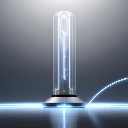![]() Single-photon-sources are extremely desirable devices as they can enable quantum-secure communication. But to enable a fast information exchange, a tradeoff between quantity and quality of the photons has to be considered.
Single-photon-sources are extremely desirable devices as they can enable quantum-secure communication. But to enable a fast information exchange, a tradeoff between quantity and quality of the photons has to be considered.
Secure but slow? Nanotechnology!
Single photons are the key to absolutely secure communication. The No-Cloning-Theorem states that it is impossible to reproduce a photon that has been detected once [1]; it is not possible to eavesdrop a single photon communication without distracting the information and to leave a clear fingerprint of it. Eave has no chance, Alice and Bob can talk about their affairs in total privacy. The concept is not new, a standard protocol exists as of 1984 [2] and its applibility has been demonstrated more than ten years ago [3].
But as it is true for all good concepts, single photon communication has yet to overcome several engineering barriers before we can easily buy real-world devices. One of these barriers is the sheer number of photons available by state-of-the-art single photon sources like molecules [4], defect centers in diamonds [5] and quantum dots [6]. The rate of these sources is generally in the GHz regime, which is just too small for high-throughput digital communication. Recent advances in nanotechnology offer several attempts to accelerate the emission of single photons by coupling quantum systems like molecules or quantum dots to nanoantennas. Nanoantennas can confine energy to tiny volumes and are able to efficiently transform the energy of quantum systems into free-space radation. In result, the photon emission rate of the quantum systems is enhanced to a great extent as shown by Farahani et al. in 2005 [7].
Quantity vs. quality: a matter of statistics
Back in 2005, it was not clear how the enhanced emission rate influences the statistics of the emitted light. The pertinent question was if the photons still have a single photon character or if they tend to be bunched, i.e. is the emission enhancement a tradeoff between quantity and quality? Light was shed on this fundamental question by attaching quantum dots to wire nanoantennas in 2007 [8]. In that experiment, Akimov and co-workers demonstrated that indeed the emitted photons obey single photon characteristic although a certain possibility remained that more than one photons are detected at a time. This result demonstrated the possibility of accelerated single-photon sources but raised another question: Is there a restriction in the emission enhancement until the single photon character is destroyed?
This question is at the core for the design of nanoantennas for high-throughput single photon sources and has been discussed in a recent publication entitled “Nanoantennas for ultra-bright single photon sources” [9]. The authors use a cavity quantum electrodynamics approach to understand the mutual interaction of the nanoantenna field and a quantum dot placed in its feed. This quantization approach goes beyond usual calculations of enhanced emission rates and enables the computation of the emitted light statistics. The authors find a fundamental tradeoff between the rate of light emission and its single photon character, a tradeoff between quantity and quality.
This tradeoff has not been considered so far and introduces a paradigm shift to the understanding of light-matter-interactions on the nanoscale. The finding underlines that fully quantum calculations are urgently needed to determine and predict the physical quantities of nanoscopic devices. The next few years will show how the scientific community will react on this “call to quantization”.
References
[1] Wootters, William; Zurek, Wojciech, "A Single Quantum Cannot be cloned", Nature 299 (182) http://dx.doi.org/10.1038%2F299802a0
[2] C. H. Bennett and G. Brassard, “Quantum cryptography: Public key distribution and coin tossing”, in Proceedings of IEEE International Conference on Computers, Systems and Signal Processing, pp. 175-179 (1984), pdf & C. H. Bennett et al., “Quantum cryptography without Bell’s theorem”, Phys. Rev. Lett. 68 (1992), http://dx.doi.org/10.1103/PhysRevLett.68.557
[3] A. Beveratos et al., “Single Photon Quantum Cryptography”, Phys. Rev. Lett. 89 (2002), http://dx.doi.org/10.1103/PhysRevLett.89.187901, E. Waks et al., “Secure communication: Quantum cryptography with a photon turnstile”, Nature 420 (2002), http://dx.doi.org/10.1038/420762a
[4] C. Brunel et al., “Triggered Source of Single Photons based on Controlled Single Molecule Fluorescence” and Phys. Rev. Lett. 83 (1999), http://dx.doi.org/10.1103/PhysRevLett.83.2722, B. Lounis and W. E. Moerner, “Single photons on demand from a single molecule at room temperature”, Nature 407 (2000), http://dx.doi.org/10.1038/35035032
[5] C. Kurtsiefer et al, “Stable solid-state source of single photons”, Phys. Rev. Lett. 85 (2000), http://dx.doi.org/10.1103/PhysRevLett.85.290 and A. Beveratos et al., “Nonclassical radiation from diamond nanocrystals”, Phys. Rev. A 64 (2001), http://dx.doi.org/10.1103/PhysRevA.64.061802
[6] J. Kim et al., “A single-photon turnstile device”, Nature 397 (1999), http://dx.doi.org/10.1038/17295, P. Michler et al., “A quantum dot single-photon turnstile device”, Science 290 (2000), http://dx.doi.org/10.1126/science.290.5500.2282, C. Santori et al., “Triggered single photons from a quantum dot”, Phys. Rev. Lett 86 (2001), http://dx.doi.org/10.1103/PhysRevLett.86.1502 and Z. Yuan et al., “Electrically driven single-photon source”, Science 4 (2002), http://dx.doi.org/10.1126/science.1066790
[7] J.N. Farahani et al., “Single Quantum Dot Coupled to a Scanning Optical Antenna: A Tunable Superemitter”, Phys. Rev. Lett 95 (2005), http://dx.doi.org/10.1103/PhysRevLett.95.017402 and A. Kinkhabwala et al., “Large single-molecule fluorescence enhancements produced by a bowtie nanoantenna”, Nat. Photonics 3 (2009), http://dx.doi.org/10.1038/nphoton.2009.187
[8] A. V. Akimov et al., “Generation of single optical plasmons in metallic nanowires coupled to quantum dots”, Nature 450 (2007), http://dx.doi.org/10.1038/nature06230
[9] R. Filter et al., “Nanoantennas for ultra-bright single photon sources”, Opt. Lett. 39 (2014), http://dx.doi.org/10.1364/OL.39.001246












